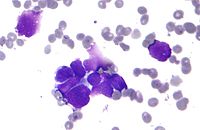
Photo from wikipedia
Background/Aim: The aim of this study was to examine the clinicopathological features of pancreatic adenosquamous carcinoma (PASC). Patients and Methods: Our study included seven patients who underwent resection of PASC.… Click to show full abstract
Background/Aim: The aim of this study was to examine the clinicopathological features of pancreatic adenosquamous carcinoma (PASC). Patients and Methods: Our study included seven patients who underwent resection of PASC. Results: PASC is characterized by large tumors and strong infiltration into the major blood vessels and other organs, forcing many patients to undergo extended resections. In addition, all patients experienced liver metastasis recurrence following surgery, with a very poor prognosis. Histopathologically, a poorly differentiated sarcomatous component existed in all patients in addition to an adenocarcinoma component and squamous carcinoma component. Although P40 staining for the sarcomatous component was positive along with squamous carcinoma, E-cadherin expression disappeared while vimentin was expressed. It has been suggested that it is highly likely that these sarcomatous components are derived from squamous carcinoma and have an impact on prognosis. Conclusion: The sarcomatous component may be related to the biological malignancy of PASC.
Journal Title: AntiCancer Research
Year Published: 2019
Link to full text (if available)
Share on Social Media: Sign Up to like & get
recommendations!